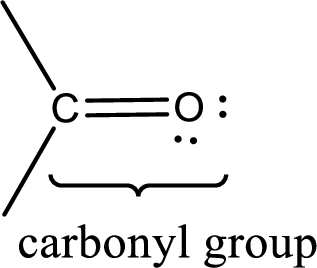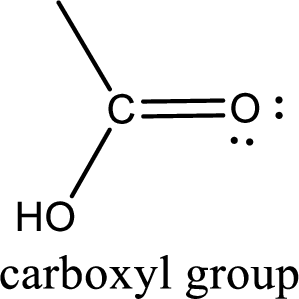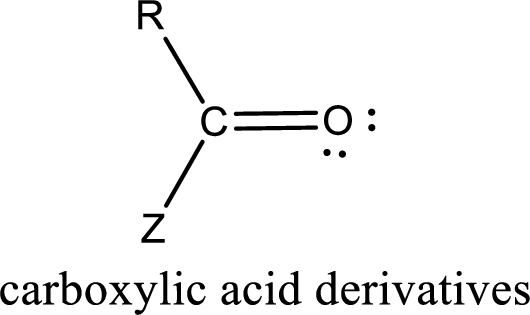
EBK GENERAL, ORGANIC, AND BIOLOGICAL CH
7th Edition
ISBN: 9780100853188
Author: STOKER
Publisher: YUZU
expand_more
expand_more
format_list_bulleted
Question
Chapter 16, Problem 16.78EP
Interpretation Introduction
Interpretation:
Two linear notations for the ester
Concept Introduction:
Carbonyl groups are the one which contain a double bond between carbon and oxygen atom.

If a hydroxyl group is attached to a carbonyl group means it is known as carboxyl group. This can be represented as shown below,


Expert Solution & Answer
Want to see the full answer?
Check out a sample textbook solution
Students have asked these similar questions
Can I please get the blank spaces answered/answers?
1. Identify the following alkenes as E or Z
NH₂
Br
2. Draw the structures based on the IUPAC names
(3R,4R)-3-bromo-4-fluoro-
1-hexene
(Z)-4-bromo-2-iodo-3-ethyl-
3-heptene
تر
3. For the following, predict all possible elimination product(s) and circle the major product.
HO
H₂SO4
Heat
80
F4
OH
H2SO4
Heat
어요
F5
F6
1
A
DII
4
F7
F8
F9
%
&
5
6
7
* ∞
8
BAB
3
E
R
T
Y
U
9
F
D
G
H
J
K
O
A
F11
F10
Draw the major product of this reaction. Ignore inorganic
byproducts.
○
O
1. H₂O, pyridine
2. neutralizing work-up
a
N
W
X
人
P
Chapter 16 Solutions
EBK GENERAL, ORGANIC, AND BIOLOGICAL CH
Ch. 16.1 - Prob. 1QQCh. 16.1 - Prob. 2QQCh. 16.1 - Prob. 3QQCh. 16.1 - Prob. 4QQCh. 16.1 - Prob. 5QQCh. 16.2 - Prob. 1QQCh. 16.2 - Prob. 2QQCh. 16.2 - Prob. 3QQCh. 16.2 - Prob. 4QQCh. 16.2 - Prob. 5QQ
Ch. 16.3 - Prob. 1QQCh. 16.3 - Prob. 2QQCh. 16.3 - Prob. 3QQCh. 16.4 - Prob. 1QQCh. 16.4 - Prob. 2QQCh. 16.4 - Prob. 3QQCh. 16.5 - Prob. 1QQCh. 16.5 - Prob. 2QQCh. 16.5 - Prob. 3QQCh. 16.6 - Prob. 1QQCh. 16.6 - Prob. 2QQCh. 16.7 - Prob. 1QQCh. 16.7 - Prob. 2QQCh. 16.7 - Prob. 3QQCh. 16.8 - Prob. 1QQCh. 16.8 - Prob. 2QQCh. 16.8 - Prob. 3QQCh. 16.8 - Prob. 4QQCh. 16.9 - Prob. 1QQCh. 16.9 - Prob. 2QQCh. 16.10 - Prob. 1QQCh. 16.10 - Prob. 2QQCh. 16.11 - Prob. 1QQCh. 16.11 - Prob. 2QQCh. 16.11 - Prob. 3QQCh. 16.12 - Prob. 1QQCh. 16.12 - Prob. 2QQCh. 16.12 - Prob. 3QQCh. 16.12 - Prob. 4QQCh. 16.13 - Prob. 1QQCh. 16.13 - Prob. 2QQCh. 16.14 - Prob. 1QQCh. 16.14 - Prob. 2QQCh. 16.14 - Prob. 3QQCh. 16.15 - Prob. 1QQCh. 16.15 - Prob. 2QQCh. 16.15 - Prob. 3QQCh. 16.16 - Prob. 1QQCh. 16.16 - Prob. 2QQCh. 16.16 - Prob. 3QQCh. 16.17 - Prob. 1QQCh. 16.17 - Prob. 2QQCh. 16.18 - Prob. 1QQCh. 16.18 - Prob. 2QQCh. 16.18 - Prob. 3QQCh. 16.19 - Prob. 1QQCh. 16.19 - Prob. 2QQCh. 16.19 - Prob. 3QQCh. 16.19 - Prob. 4QQCh. 16.20 - Prob. 1QQCh. 16.20 - Prob. 2QQCh. 16.20 - Prob. 3QQCh. 16.20 - Prob. 4QQCh. 16 - Prob. 16.1EPCh. 16 - Prob. 16.2EPCh. 16 - Prob. 16.3EPCh. 16 - Prob. 16.4EPCh. 16 - Prob. 16.5EPCh. 16 - Prob. 16.6EPCh. 16 - Prob. 16.7EPCh. 16 - Prob. 16.8EPCh. 16 - Prob. 16.9EPCh. 16 - Prob. 16.10EPCh. 16 - Prob. 16.11EPCh. 16 - Prob. 16.12EPCh. 16 - Prob. 16.13EPCh. 16 - Prob. 16.14EPCh. 16 - Prob. 16.15EPCh. 16 - Prob. 16.16EPCh. 16 - Prob. 16.17EPCh. 16 - Prob. 16.18EPCh. 16 - Prob. 16.19EPCh. 16 - Prob. 16.20EPCh. 16 - Prob. 16.21EPCh. 16 - Prob. 16.22EPCh. 16 - Prob. 16.23EPCh. 16 - Prob. 16.24EPCh. 16 - Prob. 16.25EPCh. 16 - Prob. 16.26EPCh. 16 - Prob. 16.27EPCh. 16 - Prob. 16.28EPCh. 16 - Prob. 16.29EPCh. 16 - Prob. 16.30EPCh. 16 - Prob. 16.31EPCh. 16 - Prob. 16.32EPCh. 16 - Prob. 16.33EPCh. 16 - Prob. 16.34EPCh. 16 - Prob. 16.35EPCh. 16 - Prob. 16.36EPCh. 16 - Prob. 16.37EPCh. 16 - Prob. 16.38EPCh. 16 - Prob. 16.39EPCh. 16 - Prob. 16.40EPCh. 16 - Determine the maximum number of hydrogen bonds...Ch. 16 - Prob. 16.42EPCh. 16 - Prob. 16.43EPCh. 16 - Prob. 16.44EPCh. 16 - Prob. 16.45EPCh. 16 - Prob. 16.46EPCh. 16 - Prob. 16.47EPCh. 16 - Prob. 16.48EPCh. 16 - Prob. 16.49EPCh. 16 - Prob. 16.50EPCh. 16 - Prob. 16.51EPCh. 16 - Prob. 16.52EPCh. 16 - Prob. 16.53EPCh. 16 - Prob. 16.54EPCh. 16 - Prob. 16.55EPCh. 16 - Prob. 16.56EPCh. 16 - Give the IUPAC name for each of the following...Ch. 16 - Give the IUPAC name for each of the following...Ch. 16 - Prob. 16.59EPCh. 16 - Give the common name for each of the carboxylic...Ch. 16 - Prob. 16.61EPCh. 16 - Write a chemical equation for the preparation of...Ch. 16 - Prob. 16.63EPCh. 16 - Prob. 16.64EPCh. 16 - Prob. 16.65EPCh. 16 - Prob. 16.66EPCh. 16 - Prob. 16.67EPCh. 16 - Prob. 16.68EPCh. 16 - Prob. 16.69EPCh. 16 - Prob. 16.70EPCh. 16 - Prob. 16.71EPCh. 16 - Prob. 16.72EPCh. 16 - Prob. 16.73EPCh. 16 - Prob. 16.74EPCh. 16 - Prob. 16.75EPCh. 16 - Prob. 16.76EPCh. 16 - Prob. 16.77EPCh. 16 - Prob. 16.78EPCh. 16 - Prob. 16.79EPCh. 16 - Prob. 16.80EPCh. 16 - Prob. 16.81EPCh. 16 - Prob. 16.82EPCh. 16 - Prob. 16.83EPCh. 16 - Prob. 16.84EPCh. 16 - Prob. 16.85EPCh. 16 - Prob. 16.86EPCh. 16 - Prob. 16.87EPCh. 16 - Prob. 16.88EPCh. 16 - Prob. 16.89EPCh. 16 - Prob. 16.90EPCh. 16 - Prob. 16.91EPCh. 16 - Prob. 16.92EPCh. 16 - Assign an IUPAC name to each of the following...Ch. 16 - Prob. 16.94EPCh. 16 - Prob. 16.95EPCh. 16 - Prob. 16.96EPCh. 16 - Prob. 16.97EPCh. 16 - Prob. 16.98EPCh. 16 - Prob. 16.99EPCh. 16 - Prob. 16.100EPCh. 16 - How many carbon atoms are present in a molecule of...Ch. 16 - Prob. 16.102EPCh. 16 - Prob. 16.103EPCh. 16 - Prob. 16.104EPCh. 16 - Prob. 16.105EPCh. 16 - Prob. 16.106EPCh. 16 - Prob. 16.107EPCh. 16 - Prob. 16.108EPCh. 16 - Prob. 16.109EPCh. 16 - Prob. 16.110EPCh. 16 - Prob. 16.111EPCh. 16 - Prob. 16.112EPCh. 16 - Prob. 16.113EPCh. 16 - Prob. 16.114EPCh. 16 - Prob. 16.115EPCh. 16 - Prob. 16.116EPCh. 16 - Prob. 16.117EPCh. 16 - Prob. 16.118EPCh. 16 - Prob. 16.119EPCh. 16 - Prob. 16.120EPCh. 16 - Prob. 16.121EPCh. 16 - Prob. 16.122EPCh. 16 - Prob. 16.123EPCh. 16 - Prob. 16.124EPCh. 16 - Prob. 16.125EPCh. 16 - Prob. 16.126EPCh. 16 - Prob. 16.127EPCh. 16 - Prob. 16.128EPCh. 16 - Prob. 16.129EPCh. 16 - Prob. 16.130EPCh. 16 - Prob. 16.131EPCh. 16 - Prob. 16.132EPCh. 16 - Prob. 16.133EPCh. 16 - Prob. 16.134EPCh. 16 - Prob. 16.135EPCh. 16 - Prob. 16.136EPCh. 16 - Prob. 16.137EPCh. 16 - Prob. 16.138EPCh. 16 - Prob. 16.139EPCh. 16 - Prob. 16.140EPCh. 16 - Prob. 16.141EPCh. 16 - Prob. 16.142EPCh. 16 - Prob. 16.143EPCh. 16 - Prob. 16.144EPCh. 16 - Prob. 16.145EPCh. 16 - Prob. 16.146EPCh. 16 - Prob. 16.147EPCh. 16 - Prob. 16.148EPCh. 16 - Draw a condensed structural formula for the...Ch. 16 - Prob. 16.150EPCh. 16 - Prob. 16.151EPCh. 16 - Prob. 16.152EPCh. 16 - Prob. 16.153EPCh. 16 - Prob. 16.154EPCh. 16 - Prob. 16.155EPCh. 16 - Prob. 16.156EPCh. 16 - Prob. 16.157EPCh. 16 - Prob. 16.158EPCh. 16 - Prob. 16.159EPCh. 16 - Prob. 16.160EPCh. 16 - Prob. 16.161EPCh. 16 - Prob. 16.162EPCh. 16 - Prob. 16.163EPCh. 16 - Prob. 16.164EP
Knowledge Booster
Similar questions
- ✓ Check the box under each molecule that has a total of five ẞ hydrogens. If none of the molecules fit this description, check the box underneath the table. tab OH CI 0 Br xx Br None of these molecules have a total of five ẞ hydrogens. esc Explanation Check caps lock shift 1 fn control 02 F2 W Q A N #3 S 80 F3 E $ t 01 205 % 5 F5 & 7 © 2025 McGraw Hill LLC. All Rights Reserved. Terms of Use | Privacy Center | Accessibility FT * 8 R T Y U כ F6 9 FIG F11 F D G H J K L C X V B < N M H option command P H + F12 commandarrow_forwardDraw the major product of this reaction. Ignore inorganic byproducts and the carboxylic acid side product. O 1. CHзMgBr (excess) 2. H₂O ✓ W X 人arrow_forwardIf cyclopentyl acetaldehyde reacts with NaOH, state the product (formula).arrow_forward
- Draw the major product of this reaction. Ignore inorganic byproducts. N S S HgCl2, H2SO4 く 8 W X Parrow_forwardtab esc く Drawing the After running various experiments, you determine that the mechanism for the following reaction occurs in a step-wise fashion. Br + OH + Using this information, draw the correct mechanism in the space below. 1 Explanation Check F2 F1 @2 Q W A os lock control option T S # 3 80 F3 Br $ 4 0105 % OH2 + Br Add/Remove step X C F5 F6 6 R E T Y 29 & 7 F D G H Click and drag to start drawing a structure. © 2025 McGraw Hill LLC. All Rights Reserved. Terms of Use | Privacy Ce A F7 DII F8 C Ո 8 * 9 4 F10 F C J K L C V Z X B N M H command P ge Coarrow_forwardIndicate compound A that must react with ethylbenzene to obtain 4-ethylbenzene-1-sulfonic acid. 3-bromo-4-ethylbenzene-1-sulfonic acid.arrow_forward
- Part 1 of 2 Draw the structure of A, the minor E1 product of the reaction. esc I Skip Part Check H₂O, D 2 A + Click and drag to start drawing a structure. -0- F1 F2 1 2 # 3 Q A 80 F3 W E S D F4 $ 4 % 5 F5 ㅇ F6 R T Y F G X 5 & 7 + Save 2025 McGraw Hill LLC. All Rights Reserved. DII F7 F8 H * C 80 J Z X C V B N 4 F9 6arrow_forwardFile Preview The following is a total synthesis of the pheromone of the western pine beetle. Such syntheses are interesting both because of the organic chemistry, and because of the possibility of using species specific insecticides, rather than broad band insecticides. Provide the reagents for each step. There is some chemistry from our most recent chapter in this synthesis, but other steps are review from earlier chapters. (8 points) COOEt COOEt A C COOEt COOEt COOH B OH OTS CN D E See the last homework set F for assistance on this one. H+, H₂O G OH OH The last step is just nucleophilic addition reactions, taking the ketone to an acetal, intramolecularly. But it is hard to visualize the three dimensional shape as it occurs. Frontalin, pheromone of the western pine beetlearrow_forwardFor the reaction below: 1. Draw all reasonable elimination products to the right of the arrow. 2. In the box below the reaction, redraw any product you expect to be a major product. C Major Product: Check + ◎ + X ง © Cl I F2 80 F3 I σ F4 I F5 NaOH Click and drawing F6 A 2025 McGraw Hill LLC. All Rights E F7 F8 $ # % & 2 3 4 5 6 7 8 Q W E R T Y U A S D F G H Jarrow_forward
- Can I please get help with this graph. If you can show exactly where it needs to pass through.arrow_forwardN Draw the major product of this reaction. Ignore inorganic byproducts. D 1. H₂O, pyridine 2. neutralizing work-up V P W X DE CO e C Larrow_forwardDraw the major product of this reaction. Ignore inorganic byproducts. N O' 1. H2O, pyridine 2. neutralizing work-up く 8 W aarrow_forward
arrow_back_ios
SEE MORE QUESTIONS
arrow_forward_ios
Recommended textbooks for you
 Organic And Biological ChemistryChemistryISBN:9781305081079Author:STOKER, H. Stephen (howard Stephen)Publisher:Cengage Learning,
Organic And Biological ChemistryChemistryISBN:9781305081079Author:STOKER, H. Stephen (howard Stephen)Publisher:Cengage Learning, General, Organic, and Biological ChemistryChemistryISBN:9781285853918Author:H. Stephen StokerPublisher:Cengage Learning
General, Organic, and Biological ChemistryChemistryISBN:9781285853918Author:H. Stephen StokerPublisher:Cengage Learning Chemistry for Today: General, Organic, and Bioche...ChemistryISBN:9781305960060Author:Spencer L. Seager, Michael R. Slabaugh, Maren S. HansenPublisher:Cengage Learning
Chemistry for Today: General, Organic, and Bioche...ChemistryISBN:9781305960060Author:Spencer L. Seager, Michael R. Slabaugh, Maren S. HansenPublisher:Cengage Learning World of Chemistry, 3rd editionChemistryISBN:9781133109655Author:Steven S. Zumdahl, Susan L. Zumdahl, Donald J. DeCostePublisher:Brooks / Cole / Cengage Learning
World of Chemistry, 3rd editionChemistryISBN:9781133109655Author:Steven S. Zumdahl, Susan L. Zumdahl, Donald J. DeCostePublisher:Brooks / Cole / Cengage Learning Chemistry: The Molecular ScienceChemistryISBN:9781285199047Author:John W. Moore, Conrad L. StanitskiPublisher:Cengage LearningChemistry: Matter and ChangeChemistryISBN:9780078746376Author:Dinah Zike, Laurel Dingrando, Nicholas Hainen, Cheryl WistromPublisher:Glencoe/McGraw-Hill School Pub Co
Chemistry: The Molecular ScienceChemistryISBN:9781285199047Author:John W. Moore, Conrad L. StanitskiPublisher:Cengage LearningChemistry: Matter and ChangeChemistryISBN:9780078746376Author:Dinah Zike, Laurel Dingrando, Nicholas Hainen, Cheryl WistromPublisher:Glencoe/McGraw-Hill School Pub Co

Organic And Biological Chemistry
Chemistry
ISBN:9781305081079
Author:STOKER, H. Stephen (howard Stephen)
Publisher:Cengage Learning,

General, Organic, and Biological Chemistry
Chemistry
ISBN:9781285853918
Author:H. Stephen Stoker
Publisher:Cengage Learning

Chemistry for Today: General, Organic, and Bioche...
Chemistry
ISBN:9781305960060
Author:Spencer L. Seager, Michael R. Slabaugh, Maren S. Hansen
Publisher:Cengage Learning

World of Chemistry, 3rd edition
Chemistry
ISBN:9781133109655
Author:Steven S. Zumdahl, Susan L. Zumdahl, Donald J. DeCoste
Publisher:Brooks / Cole / Cengage Learning

Chemistry: The Molecular Science
Chemistry
ISBN:9781285199047
Author:John W. Moore, Conrad L. Stanitski
Publisher:Cengage Learning

Chemistry: Matter and Change
Chemistry
ISBN:9780078746376
Author:Dinah Zike, Laurel Dingrando, Nicholas Hainen, Cheryl Wistrom
Publisher:Glencoe/McGraw-Hill School Pub Co